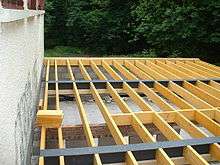Blocking (construction)
Blocking (in American English) is the use of short pieces (blocks) of dimensional lumber in wood framed construction. Uses include filling, spacing, joining, or reinforcing members.[1] Blocking is typically made from short off-cuts or defective, warped pieces of lumber. Names for similar materials in other forms of English include dwang, nog, noggin, and nogging.

The term Blocking is also sometimes used by people in construction to refer to discontinuous shims or spacers.
Uses
Some blocking is used structurally like cross bracing between joists in a subfloor to prevent buckling and stiffen the floor. This use is also called block bridging, solid bridging, and solid strutting.[2]
Fire-blocking is a firestop.[3]
Blocks are spacers between studs such as where an interior wall attaches an exterior wall and for framing corners such as a "three-stud corner with blocking".[4]
Blocking is used for panel edge supports such as sheets of drywall or plywood[5] also called back blocking[6]
Blocking, often called backing or sometimes grounds,[7] also refers to pieces of wood or other material that run between wall studs in order to provide support and attachment sites for mounted hardware or trim such as cabinets, shelving, handrails, vanity tops without a cabinet underneath, bathroom towel bars, mouldings etc. Properly installed blocking is easier to find and use for attaching wall hardware than studs alone. Once drywall, or any other material, covers the wall it can be difficult to find 2x4 studs for attachment, and the position of nails and screws must be adjusted to stud location. Thus, if blocking is installed at a uniform and predetermined height, attachment sites can be found without using a stud finder, and the blocking can be utilized anywhere along a wall at that height. This is particularly useful for installing upper cabinets in kitchens or bathrooms as they tend to be fairly heavy and finding appropriate studs for installation can be difficult.
Types
There are several types of blocking used within residential structures, all of which is specified in the IRC.
References
- "Blocking". dictionary.com. Retrieved 10 February 2015.
- "Block bridging", RSMeans Illustrated Construction Dictionary. Student ed. Hoboken, N.J.: Wiley, 2013. Print.
- Ching, Francis D. K., and Steven R. Winkel. Building Codes Illustrated: A Guide to Understanding the 2006 International Building Code. 2nd ed. Hoboken, N.J.: John Wiley & Sons, 2007. 94 Print.
- Peters, Rick. Basic Framing. Stirling Publishers: New York. 2008. 68. Print.
- Parker, Harry, and Harold Dana Hauf. Simplified Engineering for Architects and Builders. 5th ed. New York: Wiley, 1975. 231. Print.
- Simmons, H. Leslie. Olin's Construction: Principles, Materials, and Methods. 9th ed. Hoboken: J. Wiley & Sons, 2011. Print.
- Savage, Craig. Trim Carpentry Techniques: Installing Doors, Windows, Base, and Crown. Newtown, Conn.: Taunton, 1989. 68. Print.